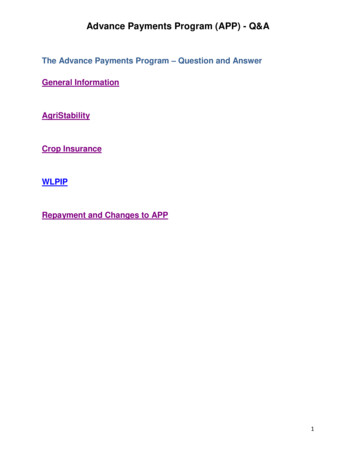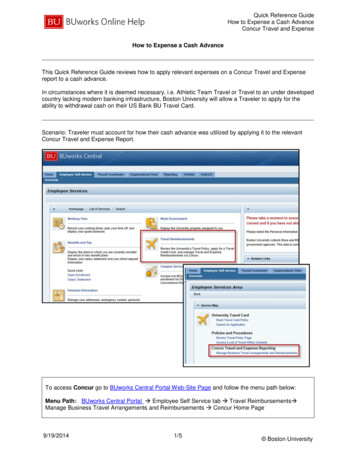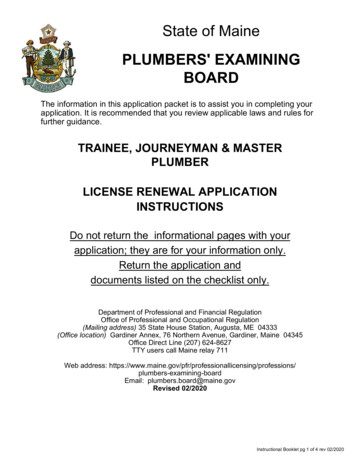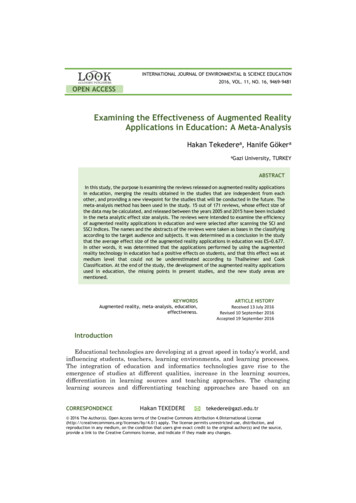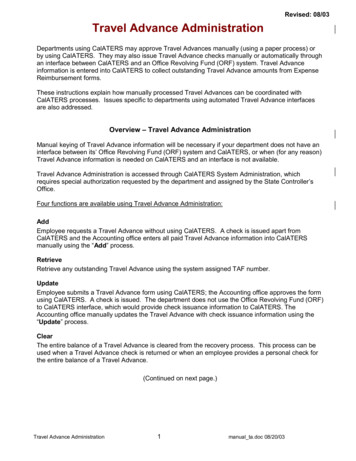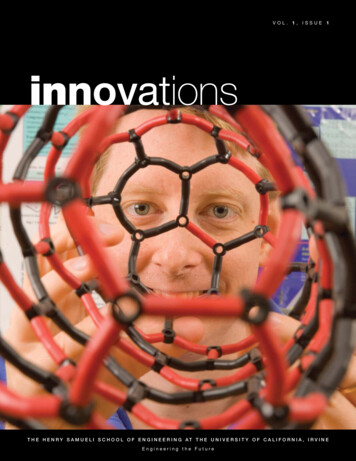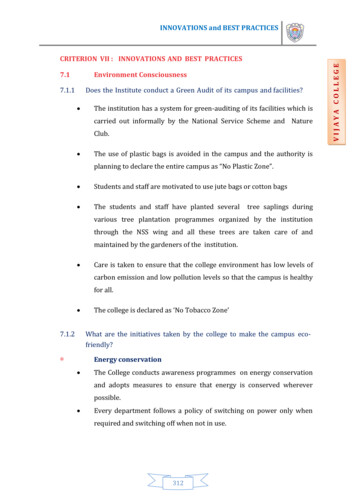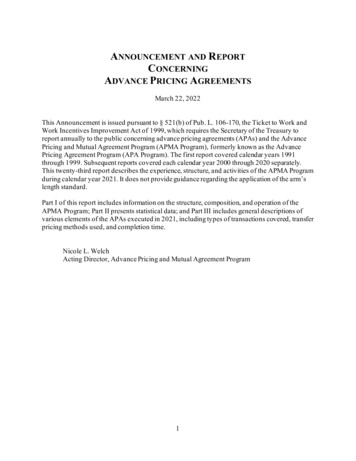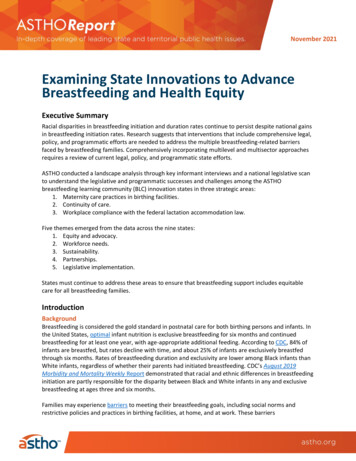
Transcription
November 2021Examining State Innovations to AdvanceBreastfeeding and Health EquityExecutive SummaryRacial disparities in breastfeeding initiation and duration rates continue to persist despite national gainsin breastfeeding initiation rates. Research suggests that interventions that include comprehensive legal,policy, and programmatic efforts are needed to address the multiple breastfeeding-related barriersfaced by breastfeeding families. Comprehensively incorporating multilevel and multisector approachesrequires a review of current legal, policy, and programmatic state efforts.ASTHO conducted a landscape analysis through key informant interviews and a national legislative scanto understand the legislative and programmatic successes and challenges among the ASTHObreastfeeding learning community (BLC) innovation states in three strategic areas:1. Maternity care practices in birthing facilities.2. Continuity of care.3. Workplace compliance with the federal lactation accommodation law.Five themes emerged from the data across the nine states:1. Equity and advocacy.2. Workforce needs.3. Sustainability.4. Partnerships.5. Legislative implementation.States must continue to address these areas to ensure that breastfeeding support includes equitablecare for all breastfeeding families.IntroductionBackgroundBreastfeeding is considered the gold standard in postnatal care for both birthing persons and infants. Inthe United States, optimal infant nutrition is exclusive breastfeeding for six months and continuedbreastfeeding for at least one year, with age-appropriate additional feeding. According to CDC, 84% ofinfants are breastfed, but rates decline with time, and about 25% of infants are exclusively breastfedthrough six months. Rates of breastfeeding duration and exclusivity are lower among Black infants thanWhite infants, regardless of whether their parents had initiated breastfeeding. CDC’s August 2019Morbidity and Mortality Weekly Report demonstrated that racial and ethnic differences in breastfeedinginitiation are partly responsible for the disparity between Black and White infants in any and exclusivebreastfeeding at ages three and six months.Families may experience barriers to meeting their breastfeeding goals, including social norms andrestrictive policies and practices in birthing facilities, at home, and at work. These barriers
disproportionately affect Black, Indigenous, and people of color, and families with lower socioeconomicstatus. Racial and ethnic bias among healthcare providers can further contribute to these disparities.Specifically, research shows that low-income minority women report the following barriers tobreastfeeding:1. Language and literacy barriers.2. Lack of social, work, and cultural acceptance or support.3. Insufficient breastfeeding education and support from healthcare providers.4. Lifestyle choices, including tobacco and alcohol use.This report describes the work of nine states participating in the ASTHO BLC State Innovations toAdvance Breastfeeding and Health Equity grant program.State Legislation to Support BreastfeedingAlthough all 50 states, Washington, D.C., Puerto Rico, and the United States Virgin Islands have lawsauthorizing women to breastfeed in any public or private area, there remain legal barriers tobreastfeeding. A common obstacle for breastfeeding mothers is navigating employment while makingtime to breastfeed or express human milk. Federal law requires that particular public buildings includelactation rooms for breastfeeding parents and require certain employers to provide a breastfeedingemployee with reasonable break time during the workday to express human milk for at least one yearfollowing the birth of a child. States have enacted more expansive laws to protect breastfeedingemployees by requiring specific employers to compensate employees during breaks to express humanmilk, extending the time an employee is to be granted breaks to express human milk, or requiringemployers to provide breastfeeding employees private space to breastfeed that is not a bathroom ortoilet stall. In 2020, Oklahoma joined 31 other states, Washington, D.C., and Puerto Rico in enactingworkplace protection laws related to breastfeeding employees.Beyond reducing barriers to breastfeeding, state laws also positively promote breastfeeding. Forexample, in 2019, Illinois amended its Medical Patient Rights Act to provide pregnant persons the rightto receive information about breastfeeding. Similarly, a 2019 New York state law empowersbreastfeeding parents to seek lactation counseling services directly without a referral from anothermedical professional. Over the past two years, Connecticut, Illinois, and New Jersey each passed lawsproviding financial reimbursement for pasteurized, donated human milk.Breastfeeding Learning CommunityIn 2018, with support from CDC’s Division of Nutrition, Physical Activity, and Obesity, ASTHO launchedthe second cohort of its five-year BLC, comprising 16 State Physical Activity and Nutrition Programrecipients. ASTHO used its learning community model to support states in implementing sustainable,scalable approaches to improve breastfeeding rates and address breastfeeding barriers using threeevidence-based strategies:1. Maternity care practices in birthing facilities.2. Continuity of care.3. Workplace compliance with the federal lactation accommodation law.Innovation GrantIn 2019, to further support this effort, ASTHO awarded nine BLC state grants (Alaska, Arkansas,Colorado, Illinois, Missouri, Ohio, Pennsylvania, Utah, and Washington state) to create innovative2
policies, systems, and cultural change in breastfeeding support. States created vision statements,transformative systems frameworks, and innovative approaches for achieving breastfeeding equity incollaboration with local partners. In addition, state projects focused on building and sustaining healthequity in breastfeeding.These states developed comprehensive, integrated strategies emphasizing community collaborationsthat represent the community voice to eliminate breastfeeding barriers in community, clinical, and worksettings. Evidence suggests that addressing the multiple breastfeeding barriers faced by breastfeedingfamilies requires a multilevel approach that includes comprehensive legal, policy, and programmaticefforts. This landscape analysis will examine programmatic and legislative successes and challenges andprovide recommendations to promote healthy breastfeeding and reduce breastfeeding disparities. Theaim is to ultimately and effectively support breastfeeding parents and their infants, particularly insystemically under-resourced populations.MethodsASTHO conducted a national legislative scan and compiled a list of breastfeeding-related bills consideredduring the 2019 and 2020 legislative sessions. This project also used a qualitative approach focused onone-hour key informant interviews coded through Dedoose. The study sample consisted of the nine BLCinnovation states, which partnered with local health agencies or community-based organizations. Allprojects focus on populations with lower breastfeeding rates, including systemically marginalizedmothers and Black, Hispanic, or rural/Appalachian women. Strategies include creating new advisorycommittees or work groups consisting of low-income mothers and mothers of color, training people ofcolor as lactation counselors and educators, assisting health systems and work sites in developingbreastfeeding-friendly policies and procedures, and engaging systemically marginalized populations todetermine breastfeeding barriers and effective solutions.ASTHO created an interview guide and began the interview by reading the introduction to theinnovation state key informants, asked questions from the project overview section, and assigned keyinformants questions from two of the three focus areas based on their project area, which keyinformants then answered. ASTHO staff then read states the conclusion.Interviews took place between August and November 2020, and researchers uploaded the transcriptsfrom the recorded interviews and coding framework into Dedoose to produce codes for further analysis.ASTHO downloaded the codes from Dedoose into Excel sheets for further analysis. The evaluators thenapplied a thematic analysis to characterize and subsequently modify emergent themes through aniterative approach that combined data collection and analysis concurrently. States provided consent forstate names to be identified with their responses.ResultsLegislative ScanASTHO identified 41 breastfeeding bills introduced in 12 states during the 2019 legislative session (seeFigure 1), of which 12 were enacted into law. During the 2020 legislative session, ASTHO identified 25bills across 13 states, of which five were enacted into law. Of the nine BLC grant states, four (Arkansas,Illinois, Ohio, and Pennsylvania) considered breastfeeding legislation in 2019, and one (Missouri)3
considered breastfeeding legislation in the 2020 legislative session. Only two of the BLC grant states(Arkansas and Illinois) enacted breastfeeding laws during this period: Arkansas enacted HB 1176 in 2019, requiring the Arkansas Department of Health to establishstandards for transporting, processing, and distributing commercial human milk.In 2019, Illinois enacted HB2, establishing access to breastfeeding as a right for a pregnantpatient, and HB3509, which extends health insurance and medical assistance coverage topasteurized donated human milk.During the 2020 legislative session, Missouri considered four bills related to breastfeeding, including HB1490, which would have required the Missouri Department of Elementary and Secondary Education todevelop a model policy for accommodating breastfeeding students and employees. The interviewrespondents from Missouri note that this bill reaffirmed standards in place under the federal law ratherthan extending additional support to breastfeeding individuals. Because the considered bill did notprovide further protection than the federal law, key partners recommended that the 2020 legislationnot move forward and noted that they hope that the original legislation's sponsor collaborates with thebreastfeeding support community before drafting future legislation.Pas sCons ili s l a on i nrli s l a on i nPas slCons iri s l a on i nli s l a on i nKey Informant InterviewsBelow are descriptions of each of the state breastfeeding learning community programs.Alaska engaged community program staff and focused on expanding existing breastfeeding supportservices into a model program that provided breastfeeding mothers with support services and outreacheducation. Arkansas had three project goals:1. Recruit a physician champion.2. Work with family medicine clinics to improve breastfeeding rates.4
3. Assess and prepare early childhood education centers for supporting breastfeeding, milkstorage, and implementation of policies and practices.Colorado convened state partners and other community organizations to address the project goal oferasing breastfeeding-related stigma. In addition to providing certified lactation education training,Colorado also held a statewide Black health and breastfeeding summit. Illinois focused on improvingcontinuity of care. To develop a vision, the state included input from seven focus groups across thestate. The vision was to provide families, especially those in systemically under-resourced communities,with equitable access to adequate and accurate culturally appropriate lactation support from peers,professionals, and communities. Illinois hosted several in-person and phone meetings with a variety ofcritical partners. While champions instituted policies in hospitals, Illinois sought state policy leaders forbreastfeeding.Missouri held focus groups designed as Black sacred spaces to measure Black women's lived experienceof giving birth in Baby-Friendly designated hospitals to document Black maternal and infant experiences.Missouri highlighted personal integrity as an essential value to build trust in any partnership. Ohioconducted focus groups with Black and Appalachian women in Ohio, two populations with lowerbreastfeeding rates, particularly in breastfeeding duration. When reflecting on partnerships, Ohio keyinformants stated that they are working within the health agency, as well as with other state agenciesand coalitions. They are also open to any other partnerships.Beyond the innovation grant period, Pennsylvania is creating a dissemination plan to share the stateaction plan that its key partners and work group developed. The work group had strong advocates forbreastfeeding, including many from different backgrounds. The group prioritized achieving proportionalrepresentation that was in line with the state population of both Black and Latinx breastfeeding mothers(or at least women of childbearing age of each population across the state).Utah noted staffing, training, and costs as barriers for hospitals to become designated as Baby-Friendly.To address this, Utah developed the Stepping Up for Utah Babies training program, an incrementalapproach to changing practices. The program includes hospital practices and policies, training for staff,and other points the Ten Steps cover, but on a more feasible implementation level. It also targetedlactation accommodations in the workplace and focused on:1. Work sites.2. Receiving funding through a mini-grant.3. Individuals of lower income.Washington state pioneered an equity-focused training event about implicit bias and how racismimpacts breastfeeding success. Their training primarily focused on racism, including the history of racismin breastfeeding promotion, why and how some populations have been systemically marginalized, andwhat needs to change. Washington state’s n a m nt with pro rammatic staff focus on nurturinconnections and providing a safe space for partners and the community. Th stat ’s work to engagepolicy staff centered around leveraging the community and community relationships to addressbreastfeeding policy, specifically for Medicaid, and establishing a bundled package for reimbursement.Maternity Practices in Birthing FacilitiesSeveral key informants noted differences in their birthing facility policies and practices. An Illinois keyinformant noted that “Illinois has a hi hly r ulat p rinatal syst m, so about half the state has a5
regulated perinatal system and about half of it’s not co ifi .” In other words, the system designatesperinatal levels of care, but not maternal levels of care. To adjust this system to recommended maternallevels of care, the project team is working with the state government to modify the code, includingmaking the code more explicit regarding breastfeeding support.When asked to describe the characterization and perception of breastfeeding among key partners,including community organizations, government, and breastfeeding support professionals, Alaska citedthat community-level support for breastfeeding initiatives is high. Alaska, Missouri, and Utah allhighlighted that self-sustaining community effort drives the change.Washington state noted that, despite having a governor who supports breastfeeding, there is still keypartner distrust of government initiatives. A Washington state key informant reported that “Thhistorical pain is a r ally bi barri r for a lot of our collaboration. I'm associat with the governmentand that immediately slows down everything. If you want to move anything working with tribes, it has tobe brought to the tribal leadership, discussed, chewed on, thought about, and then they might inviteyou to make your pitch or share a project that you're interested in. So, when the health commission andthe tribe see the department of health doing something, they're not going to want to work orcollaborate with us even if my intentions are good, even if I've worked with tribes before.”Alaska, Missouri, and Utah also said that certain processes can hinder progress and ability to work withthe state. Missouri noted, “I think, too, when we're talking about that difference between regulationsand licensure and that trust with the state, the bureaucracy is difficult to pierce, not only from outside,but also from within.”Continuity of Care (Professional and Peer Support): Education and MarketingStates discussed their region-specific ways of delivering education and marketing materials aboutbreastfeeding to the public. Alaska noted that it had a live breastfeeding web page but did not have adedicated staff member to maintain upkeep. For advertising purposes, Alaska primarily relied on wordof mouth. The state created an Alaska Breastfeeding Supported Here logo posted in public spaces inbusinesses for continued marketing.Alaska also noted that families have access to online education modules for breastfeeding andpregnancy. If someone is unable to pay, the Alaska program opts to waive the fee. It provides traditionalSpecial Supplemental Nutrition Program for Women, Infants, and Children (WIC) prenatal andbreastfeeding sessions for parents. The Alaska team will work with a contractor to develop an onlinecourse for breastfeeding training for WIC staff, up to four hours of training with every WIC staff person.The team offered a 10-step course for OB-GYN and nursing students to enhance their knowledge base.Additionally, two Alaska university nursing students took (and, hopefully, future students will continueto take) the breastfeeding course, which is available every semester. Lastly, Alaska is developing apotential class offering at Alaska Pacific University focusing on educating Alaska Native and AmericanIndians on this health disparate population.In Arkansas, before the COVID-19 pandemic, providers could find deliverables—such as breastfeedingrelated brochures, binders, window clings, and posters—in the family practice or medical clinics, or elseat the Arkansas Family Physician Conference. Since the pandemic, the state has been mailingdeliverables to clinics. Commitment letters or surveys are generally faxed or sent by mail. The Arkansasteam also created a breastfeeding promotion video. Arkansas also made an effort to represent6
additional mothers in the state by partnering with an organization in northwest Arkansas with aMarshallese population.Colorado ensured that its images and marketing (e.g., social media, email blasts, flyers) represent thestate's population with a written branding, social media, and marketing policy. The state regularly sharesinformation with its key partners group and ensures every member weighs in before releasing content.Illinois v lop social m ia m ssa s an post rs for waitin rooms at clinics or octor’s offic s thathighlight ways to receive support through WIC and lactation support professionals. The state alsoestablished a sign-up option for families to receive mail directly. Illinois partners created around 20short lactation support videos to share on social media and other networks.Missouri developed a video on YouTube about its breastfeeding partnership and offers freebreastfeeding promotion trainings to WIC and hospital personnel. Ohio established a 24/7 breastfeedinghotline and funding specifically for marketing and advertising. It put in place a team review processbefore posting anything, with a conscious image selection. The state also relied heavily on partners todisseminate information, primarily due to the ideal marketing campaign's cost burden.Pennsylvania supported individual hospitals in creating their education and marketing materials.Continuous conversations through th stat ’s work group echoed the need for marketing materials toreflect the communities they are trying to serve. The state was hoping for additional funding foreducation and marketing, but did note that the local health departments carried out a public awarenesscampaign. Generally, Pennsylvania disseminated state-created social media messaging aroundbreastfeeding and evaluation outcomes to the public.When asked to describe their breastfeeding support to uninsured or underinsured patients, Colorado,Illinois, and Pennsylvania referenced WIC resources. The Illinois team also shared that a person can beundocumented and still receive Medicaid, and Arkansas mentioned that the state has an ArkansasWorks Insurance program and a breastfeeding hotline that uninsured individuals can access.Workplace Compliance with Lactation Accommodation LawA Colorado key informant discussed the varied implementation of the lactation accommodation law,sayin , “I've actually seen lactation rooms at some community-based organizations and federallyqualified health centers. Some of them are putting them in janitor closets to accommodate the law, andthey're not that attractive, and it's scary. And then others are really building a positive peer culturearound it, making sure that it's a safe, clean, wholesome, relaxing environment with refrigerationsystems in there and all the amenities.” Th y also not that th ir stat law is strict r than fral law.Illinois partnered with a technical expert and funded local communities with the highest racialdisparities and infant mortality rates to implement lactation accommodations and workplace policies.Ohio is preparing to launch an Ohio-specific tool kit, an updated version of the federal business case forbreastfeeding. The state also expanded federal accommodation work to eight additional counties.Despite COVID-19 and many people working from home, Utah continued to advocate for workplacebreastfeeding policies by emphasizing the importance of having a policy around breastfeeding. Becauseof COVID-19, the state also discussed a suggestion for organizations to edit and to include wordingindicating that women working from home still have breaks and emphasizing that working from homestill requires paid or unpaid break times to express milk.7
Missouri emphasized that its state law for workplace accommodations is weaker than the federal law. In2020, Missouri legislators proposed a breastfeeding work site bill but did not consult the breastfeedingcoalition or other br astfin champions. Th l islation was r f rr to as, “frankly t rribl anproviding less protection than the federal law.” Th Missouri project team recommended that thelegislation not move forward and that the legislators come to the breastfeeding coalition and othersbefore writing future such legislation.Utah also spent many years crafting a breastfeeding bill and has been unable to push it through, whileWashington state helped develop a state breastfeeding policy by supporting local coalitions to continueefforts around work site accommodations and adding a complaint form online under the attorneyg n ral’s offic . None of the state codes addressed breastfeeding-related parent education.ProgressIncorporating Health EquityWhen asked about progress in incorporating health equity into programs, policies, or financial support,states discussed wanting to take advantage of every opportunity to integrate health equity into theirwork.Alaska noted disparities in the social determinants such as community and environment—not justeconomic and racial. To support all hospital patients, lactation nurses went through an adversechildhood experiences (ACEs) program, which included content on ACEs, trauma-informed care, andsexual abuse.Missouri preferred to use direct conduits to the Black community to find community members in citieswho have the lived experience of giving birth in Baby-Friendly-designated hospitals. The focus groupswere intentional Black sacred spaces, meaning only Black people could be a part of these spaces.Missouri also highlighted vaccination schedules and requirements, as well as the strain they put on Blackand non-White mothers: “Even though I know those kinds of rules of vaccination and policies are wellintentioned, what they actually typically do is put undue burdens on the back of the people at the verybottom.”By developing a robust doula program, Washington state created a safety net system to help when abirthing person experiences a microaggression in birthing facilities. Women were able to share stories ina safe space and relationship build with a support professional. Having a skilled and knowledgeabledoula who can relate to a parent at a deeper, personal level creates the steppingstones necessary tobuil in a saf spac by prot ctin th spac an b li vin som on ’s stori s an th ir p rc ption ofevents. Washington state also discussed an experience where a hospital inequitably implementedstandard protocol.Following the opioid crisis, there was a directive for the governor to develop hospital guidelines for thepostpartum setting. The language designed for the guideline included the phrase “up to yourdiscretion.” Despite the recommendation to do rooming in with the infant, sp cially if th y’rexperiencing neonatal abstinence syndrome, some nurses chose to withhold the infant, passingjudgment and stereotyping the mother by believing that she would not take care of her infant. AmericanIndian and Black women were most impacted while not having drugs in their system.8
Utah created mini-grants to improve lactation accommodation at work sites for individuals of lowerincome. In addition, Utah found it challenging to develop breastfeeding promotion language that didnot accidentally exclude other groups.ChallengesWhen asked about state progress on the innovation project, all states expressed a positive progressupdate and project flexibility despite the COVID-19 pandemic. States cited COVID-19 as the mostcommon barrier to timeline changes and project adjustments, as states shifted in-person plans to virtualopportunities.Colorado discussed an event that was originally planned to be a statewide Black health summit, butwhich was expanded to become a national Black health summit with almost 200 attendees. Coloradoalso highlighted a panel of fathers who discussed their parental role and the barriers to supportingbreastfeeding and around being a Black male.Pennsylvania noted, “Wh n I was thinkin about this, I thou ht about not only COVID, which v ryonis aware is a barrier to just about everything we're doing these days, but the weight of the trauma ofsystemic racism and the racial justice movement definitely has been voiced by our members. And I thinkas a result, the process has sometimes felt a bit rushed, I think, for folks, and they voiced that. Andwe've tried to address that. And fortunately, we were able to extend our work plan and our timeline toallow for r visitin som of th topic ar as.”Addressing and Overcoming BarriersOnce the pandemic began, Missouri addressed its concern regarding changing in-person convenings tovirtual convenings and overcame the barrier by establishing intimacy and trust through the online focusgroup. The state practiced active listening by being open to feedback and flexibility, and understandingthe community’s perception.The Ohio team faced a hiring freeze, which prevented that team from filling the nutrition andbreastfeeding role and forcing a staff member to work two jobs. Illinois echoed the benefit of havingpartners to help push the work forward. They also began collaborating with other states to presentproject work at conferences.Recommendations from StatesWhen asked if they had advice for other states, Arkansas, Colorado, Illinois, Missouri, Pennsylvania,Utah, and Washington state all mentioned the importance of researching the support and structurescurrently available within their communities.Colorado also suggested hosting a cultural bias training at the outset of the project and expressed thesignificance of bringing in trained facilitators to build an equitable platform that all parties feelcomfortable collaborating in. Illinois recommended that states be honest about their capacity to haveopen collaboration and see the work through. Utah emphasized the significance of letting partnersknow the value of the work they do. Washington state highlighted being aware that people are indifferent places and making space for everyone.Strategies and Opportunities for Sustainability9
Regarding future wishes for their project, Colorado discussed opportunities for continuation and hopesfor expansion, including a full-time program staff member embedded in each organization that candeliver outreach, convening, and training. Missouri inquired about how ASTHO and states approachworkforce development in hospitals when it comes to breastfeeding. Ohio was interested in seeingbreastfeeding expand at the state level. Utah would like more support with its breastfeeding coalition.Washington state discussed wanting to create a breastfeeding data web page that includes hospitalscores, such as California’s breastfeeding hospital web page.Discussion and ConclusionASTHO identified the following five themes in the data across the nine states describing their work withadvancing equitable breastfeeding:1. Equity and Advocacy: It is challenging to advocate for equitable breastfeeding in the statewithout addressing the historical trauma and educating key partners and legislatures.2. Workforce Needs: Diversifying the lactation workforce is an area that needs more support andresources.3. Sustainability: It is difficult to sustain and expand this work without critical resources forsupport (e.g., ongoing financial capital).4. Partnerships: Different key partners at various levels want to do this work, but withoutrelationship-building to bolster collaborations and partnerships, this will continue to bechallenging.5. Legislative Implementation: Policies and practices related to breastfeeding do not haveequitable implementation.For maternity practices in birthing facilities, the data show that historical pain and existing processesand practices are barriers for states and are associated with stakeholder distrust. These findings haveimplications for stat s’ an communiti s’ ability to buil partn rships an collabo
one-hour key informant interviews coded through Dedoose. The study sample consisted of the nine BLC innovation states, which partnered with local health agencies or community-based organizations. All projects focus on populations with lower breastfeeding rates, including systemically marginalized

